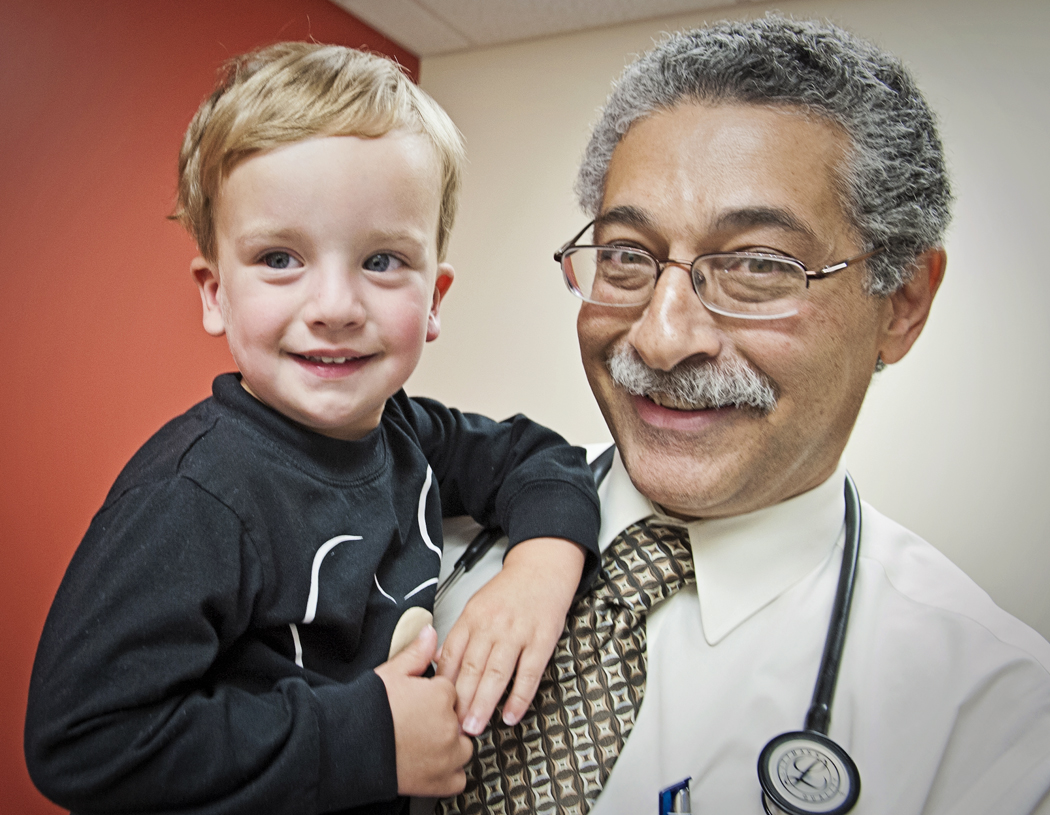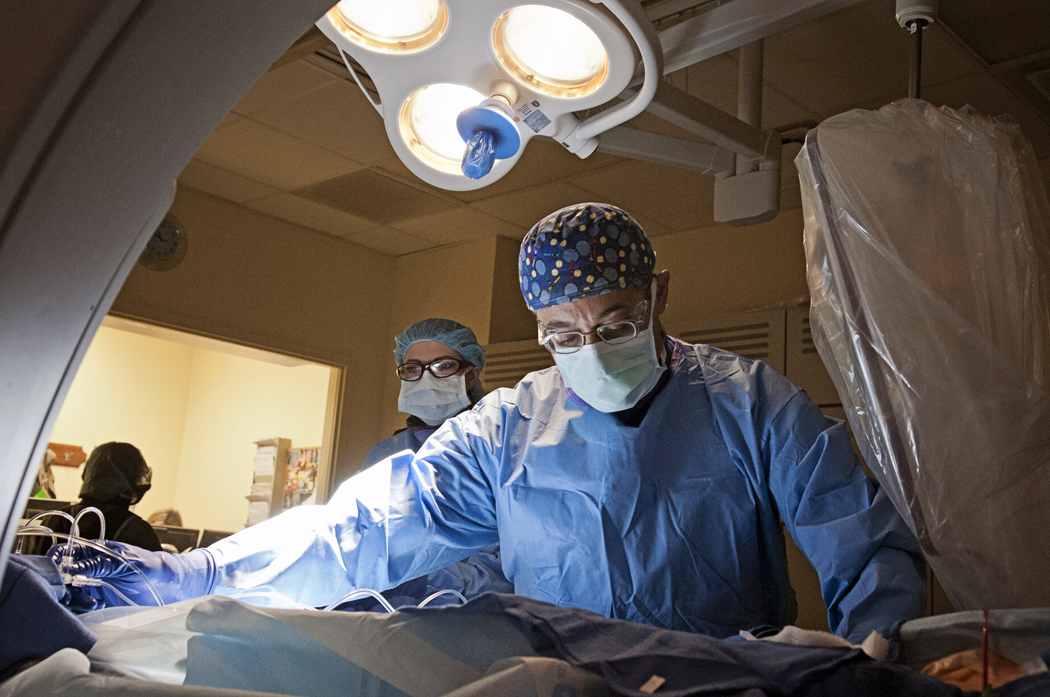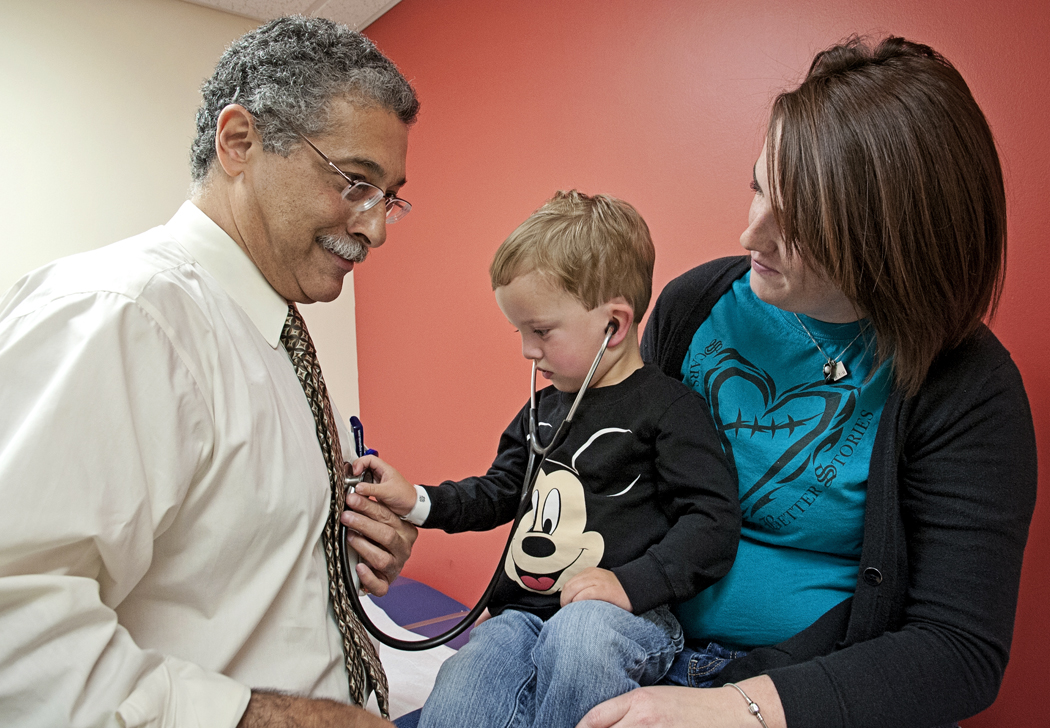New procedure at UMMC repairs heart without opening children’s chests

But a significantly less invasive procedure a University of Mississippi Medical Center pediatric cardiologist carries out in a catheterization lab is giving kids and parents a new option: A simple overnight hospital stay and a regular Band-Aid on their leg in lieu of a line of chest stitches.
Ten children have successfully undergone Dr. Makram Ebeid’s procedure to plug a perimembranous ventricular septal defect in their heart’s lower half by transporting the plug on a catheter that is advanced through the child’s leg. It’s a transformational development borne of clinical trials that could, in time, replace the decades-old standard of surgery requiring at least a three- to five-day stay and post-op care in the pediatric cardiac care unit, Ebeid said.
“It makes so much sense that this is the right thing to do,” said Ebeid, professor of pediatric cardiology and director of the Pediatric Catheterization Lab.
If more parents only knew they could avoid open-heart surgery on their babies or toddlers, many would jump at the chance, said Dr. Jorge Salazar, professor of pediatric heart surgery and co-director of the UMMC Children’s Heart Center.
“If we can achieve the exact same result using a catheter that goes up the leg, then why wouldn’t we do it?” Salazar said. “I have seven children. If one had a hole in his heart, I would choose the catheter.”
A ventricular septal defect is an opening in the septum wall that separates the heart’s left and right ventricals. That congenital flaw is almost always repaired during open-heart surgery.

Save “a few scattered cases here and there,” Ebeid said, he’s the only cardiologist placing a plug in a perimembranous ventricular septal defect in a catheterization lab. A muscular ventricular septal defect, typically located a little lower in the ventrical, is more commonly repaired in a catheterization lab.
Ebeid was chosen as part of other clinical trials to test the small, nickel-and-platinum plug manufactured by St. Jude Medical.
“He definitely is one of the pioneers,” Salazar said. “It’s too new to have exact figures. Nobody has published them yet.”
Few pediatric cardiologists are telling parents of the new treatment option, or perhaps know about it at all, Salazar said. “It’s still a very prevalent opinion in the world that this particular hole can’t be closed with a catheter, and that it shouldn’t be done,” he said. “But, that’s based on the approaches and technology of the past.”
Parents of Ebeid’s patients get all of the information – and aren’t pressured one way or the other, Ebeid said. “I’m very honest, and tell them that surgery has been tested for 30 to 40 years, and that this is new.
“A few shy away. But I tell them that if they’ll allow me to do it in the catheterization lab, that I will do that,” Ebeid said. “It’s much easier, and you’re done in a few hours, compared to having your chest opened up. I would never tell them that surgery is the wrong thing.”
Pass Christian resident Lindsey Stout chose catheterization for her 2-year-old son Wyatt. His pediatric cardiologist first discovered a “massive hole” not long after Wyatt’s birth, and after watching him carefully for a year, referred the family to Ebeid, Stout said.
“Dr. Ebeid told us 95 percent of cardiologists would just open him up, but that he felt comfortable closing it with a catheter,” Stout said. “It wasn’t a difficult decision for me.”
Ebeid discovered a total three holes, Stout said. “If we had done surgery, they would have had to break his ribs and to stop my almost 2-year-old’s heart,” she said. “The thought of that is still scary to me.”
Open-heart surgery requires placing the child on a heart-lung bypass machine. The child is temporarily on a ventilator in the pediatric ICU, but goes home in five days or less. If Ebeid concludes a patient is a better candidate for surgery, even after he’s begun catheterization, the child often can go to the operating room right then for surgery performed by Salazar.

“There are a lot of institutions closing atrial septal defects, but not many closing ventricular septal defects,” said Dr. Rick Barr, Suzan B. Thames professor and chair of pediatrics. Ebeid, he said, is receiving referrals “from other institutions where they didn’t feel comfortable closing it. And, it’s not only that he’s doing this procedure and doing it well, but on highly complex patients.”
“In terms of the global picture, it’s a little bit ironic that Mississippi is thought to be 50th in the nation on health care, but is leading the charge for advancing pediatric heart care,” Salazar said.
Ebeid and Salazar know the procedure has worked when an echocardiogram shows improved function and heart size. And, Ebeid said, there’s another sign of success, one that certainly brings joy to the heart of a parent.
“Once we’re done with the patient, they’re ready to play,” he said of toddlers like Wyatt, who rode a tiny tricycle in the pediatric ward the morning after his procedure. “They’re ready to play, even before they go home.”


